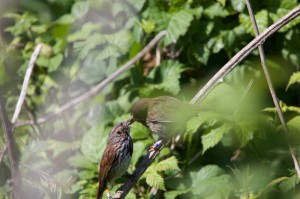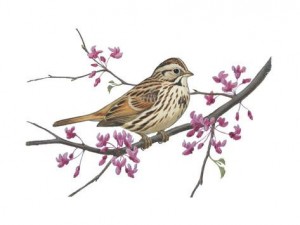Week 44 – 14 May 2017:
In Which Shrub Shall I Build My Nest?
University student who have studied conservation biology under me know my mantra. “An original, intact, operating ecosystem without any introduced species cannot be improved upon.” Whatever was in place before humans started messing things up is best. That is all perfectly good, but finding such a system, untouched by people, is a challenge. For instance, virtually every place on Earth has been affected by plants and animals that have been introduced by humans. Scientific studies of the impact of these introductions are often initiated after the invader has become established, and a complete before-and-after picture of the habitat is generally lacking.
Thank goodness, then, for a group of ornithologists at the University of British Columbia who have been studying Song Sparrows on Mandarte Island continuously since 1975. Mandarte is a six hectare island off the west coast of Canada. It hosts a community of maritime meadow plants, and is home to endangered Garry oak. It also harbours an abundance of Song Sparrows which are year-round residents. The island is a workable size, and so researchers have been able to band all of the sparrows for individual identification, and follow the progress of all of their nesting attempts. Song sparrow nest predation on the island is low, where almost all individuals nest in or next to a shrub.
Two shrubby species colonized Mandarte after 1963. They are the Himalayan blackberry, an invasive species from Eurasia, and the red elderberry, which is a native to the west coast of North America but also recognized as an aggressive invader when it colonizes a new spot. Using the long-term data available from Mandarte, Merle Crombie and his associates studied the responses of Song Sparrows to Himalayan blackberry and red elderberry.
The three most common native shrubs on Mandarte are snowberry, Nootka rose, and trailing blackberry. Coverage of these three species declined from 92% in 1986 to 58% in 2006, with the increase of the two colonizers. How did the Song Sparrows react to this change? They showed a strong preference to nest in the shrubby trailing blackberry (native) and Himalayan blackberry (introduced). The sparrows nested in the native Nootka rose and snowberry shrubs about as often as would be expected from their abundance. Of the 1051 sparrow nests in the dataset, only one was found in red elderberry, the regional native but recent colonizer; that nest failed. Excluding the single elderberry nest, the reproductive performance of Song Sparrows nesting in the other shrubs was similar.
The field of management of introduced species is incredibly complicated. Decisions about whether attempt to control or eradicate an invasive can only be based on our best guess of the costs and benefits of those actions. In the case of the Mandarte Island population of Song Sparrows, eradication of the red elderberry would probably be a good thing. This assumes that the removal of elderberry would enable natives to reestablish themselves, rather than be replaced by some other undesirable plant. It seems that eradication of Himalayan blackberry from Mandarte would make no difference to the resident Song Sparrows, but it could help to restore native plant species that are typical of the Gary oak and maritime meadow habitat which is, itself, endangered.
Crombie, M. D., R. R. Germain and P. Arcese. 2017. Nest-site preference and reproductive performance of Song Sparrows (Melospiza melodia) in historically extant and colonist shrub species. Can. J. Zool. 95:115-121.
Photo credits: Song Sparrows on Mandarte Island, © Martina Andrés – mandarte-island.weebly.com; Song Sparrow print by Walter Weber – www.allposters.com



